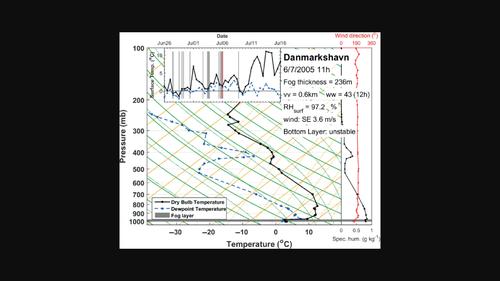东格陵兰岛沿岸的北极雾气候学
IF 3
3区 地球科学
Q2 METEOROLOGY & ATMOSPHERIC SCIENCES
引用次数: 0
摘要
摘要:本研究利用丹麦气象研究所运营的四个天气气象站在1958年至2016年间沿整个东格陵兰海岸的沿海雾的综合气候学数据。研究的因素包括雾的频率,每日时间,温度,风,能见度和无线电探空仪剖面。从低北极到高北极地区雾的时空格局与区域季节性温度、地表和高空风和海冰状况的变化有关,并与北大西洋涛动(NAO)和格陵兰阻塞指数(GBI)相关。结果表明,约70-80%的东格陵兰岛雾发生在夏季(MJJA),每年的雾发生时间与海冰破裂的开始时间接近。这种暖季雾具有典型的平流雾的特征,如无线电探空仪剖面图所示,并与温和的海风有关。超过95%的暖季雾温度高于-10°C,峰值接近0°C,因此由液体或过冷的水滴组成。在寒冷季节,混合相雾主要出现在高北极地区,约占观测量的70%。冰雾(T <-30°C)只出现在2%的观测中,并且在寒冷季节仅限于格陵兰岛东北部。高纬度北极地区冷季复合探空雾廓线的特征是深(~1000 m)和强(~6°C)地表温度逆温。在暖季,大多数大雾天气的能见度最低(<500米)和更高在寒冷的季节(<在格陵兰东北部,1981年至2016年暖季浓雾期间的能见度下降了~50 m dec - 1。在格陵兰东南部,低GBI和NAO正相期间雾能见度较高,但与气候指数没有其他相关性。这篇文章受版权保护。版权所有。本文章由计算机程序翻译,如有差异,请以英文原文为准。

A climatology of Arctic fog along the coast of East Greenland
Abstract This study presents a comprehensive climatology of coastal fog from four synoptic weather stations operated by the Danish Meteorological Institute along the entire East Greenland coast between 1958 and 2016. Elements investigated include fog frequency, daily timing, temperature, wind, visibility and radiosonde profiles during fog. The spatiotemporal patterns in fog from the low‐ to high‐Arctic locations were related to varying regional seasonal temperatures, surface and upper‐air wind and sea ice conditions, and to correlations with the North Atlantic Oscillation (NAO) and the Greenland Blocking Index (GBI). Results indicate that ~70–80% of East Greenland fog occurs in summer (MJJA), and yearly fog onset is near‐coincident with the start of sea ice break‐up. This warm‐season fog has the typical characteristics of advection fog, as shown in the radiosonde profiles and the association with a gentle sea breeze. More than 95% of warm‐season fog is warmer than –10°C, and peaks close to 0°C and, therefore, consists of liquid or supercooled water droplets. In the cold season, mixed‐phase fog prevails in the high‐Arctic locations, accounting for ~70% of observations. Ice fog (T < –30°C) occurs in only 2% of observations and is limited to Northeast Greenland during the cold season. The cold‐season composite radiosonde fog profiles in the high Arctic locations are characterized by deep (~1000 m) and strong (~6°C) surface‐based temperature inversions. Visibility during most fog conditions is lowest during the warm season (< 500 m) and higher during the cold season (< 800 m). In Northeast Greenland, visibility during warm‐season fog has decreased by ~50 m dec ‐1 between 1981 and 2016. In Southeast Greenland, fog visibility is high during low GBI and a positive phase of NAO, but no other correlations with climate indices were found. This article is protected by copyright. All rights reserved.
求助全文
通过发布文献求助,成功后即可免费获取论文全文。
去求助
来源期刊
CiteScore
16.80
自引率
4.50%
发文量
163
审稿时长
3-8 weeks
期刊介绍:
The Quarterly Journal of the Royal Meteorological Society is a journal published by the Royal Meteorological Society. It aims to communicate and document new research in the atmospheric sciences and related fields. The journal is considered one of the leading publications in meteorology worldwide. It accepts articles, comprehensive review articles, and comments on published papers. It is published eight times a year, with additional special issues.
The Quarterly Journal has a wide readership of scientists in the atmospheric and related fields. It is indexed and abstracted in various databases, including Advanced Polymers Abstracts, Agricultural Engineering Abstracts, CAB Abstracts, CABDirect, COMPENDEX, CSA Civil Engineering Abstracts, Earthquake Engineering Abstracts, Engineered Materials Abstracts, Science Citation Index, SCOPUS, Web of Science, and more.

 求助内容:
求助内容: 应助结果提醒方式:
应助结果提醒方式:


